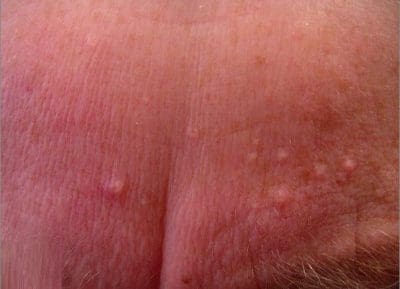Sebaceous Hyperplasia
Understanding Sebaceous Hyperplasia and the Treatment Options
Are you battling small bumps on your forehead, nose, or cheeks? Are you over the age of forty? Then there’s a chance you could have sebaceous hyperplasia. While these bumps are small and painless, they can be annoying. The spots are very difficult to get rid of, but luckily, it’s not impossible.

What is Sebaceous Hyperplasia?
Sebaceous glands are attached to hair follicles all over your body. They release sebum, which is a mixture of fats and cell debris that creates a greasy layer on your skin. This is required to keep the skin flexible and hydrated. But sometimes, the glands can become enlarged with trapped sebum, and this is when sebaceous hyperplasia forms.
These are yellowish or flesh-colored bumps that usually pop up on the forehead and nose. They are small and usually shiny. Often people mistake sebaceous hyperplasia for basal cell carcinoma. While the bumps do look similar, sebaceous hyperplasia is not cancerous like basal cell carcinoma. Your doctor may do a biopsy to determine the difference between the two.
Related Pages
Quick Quote
Sebaceous Hyperplasia Causes
There are several causes behind sebaceous hyperplasia. Age, your skin condition, genetics, and medical reasons can play big roles in developing this condition.
- Age – These bumps are most common in middle-aged or older people.
- Skin Condition – You’re most likely to get these bumps if you have fair skin and have had a lot of sun exposure. Continual sun damage can worsen the symptoms or cause them to appear earlier.
- Genetics – People are more likely to develop this skin condition if it runs in the family. There’s also a rare genetic disorder called Muir-Torre syndrome. People with this syndrome often develop this condition. Although sebaceous hyperplasia is usually harmless, it can be a sign of a tumor in people who have Muir-Torre syndrome.
- Medical Reasons – People with a suppressed immune system, taking immunosuppressant medication cyclosporine are more likely to develop sebaceous hyperplasia.
How Can I Tell if I Have Sebaceous Hyperplasia?
The main symptom of sebaceous hyperplasia is a small, shiny bump under the skin. A bump can appear on its own or in a small cluster. These are usually painless. Sometimes the bump can be difficult to distinguish between acne. The easiest way to tell them apart is that a whitehead or blackhead will usually have a lifted center, but bumps that are sebaceous hyperplasia are indented. They also usually have a white or yellow outer edge.
Diagnosis of Sebaceous Hyperplasia
A dermatologist will usually be able to diagnose sebaceous hyperplasia nose and face spots just by looking at them. This will happen in the office on the first visit. Sometimes, if the bump looks similar to basal cell carcinoma, a biopsy may be done to determine the condition. If a biopsy is done, then the sample will have to be sent to the lab, and results will be given at a later date.
Sebaceous Hyperplasia Treatment Options
While sebaceous hyperplasia is painless, the bumps can be embarrassing. Luckily, there are several options out there to have the bumps removed. You may need to be treated more than once to fully remove the glands. Here are some of the options for removing sebaceous hyperplasia or controlling sebum buildup:
1. Retinol
This is a form of vitamin A. When it’s applied to the skin, it can reduce or prevent your sebaceous glands from clogging. You can get low-concentration retinol over the counter, but if your case is severe or extensive, a full-strength prescription will work best. Retinol needs to be applied for about two weeks for you to start seeing results. You will have to keep using the cream because if you stop, your sebaceous hyperplasia will return in about a month.
2. Facial Peels
Facial peels containing chemicals like salicylic acid can be applied to help unclog the pores. Keep in mind that chemical facial peels can also cause irritation, redness, and sensitivity. You will have to make sure you receive proper aftercare to make sure the chemical doesn’t aggravate the glands.
3. Laser Therapy
Trapped sebum can be removed from the gland by using a laser. This will help smooth out the skin.
4. Cryotherapy
A dermatologist can remove the bumps by freezing them during a process called cryotherapy. After the bumps are frozen, they will dry up, and go away. The downside to this procedure is it can cause discoloration in the area.
5. Electrocauterization
This involves using a charge of electricity to burn the bump. The skin will scab over as it is healing, then fall away, leaving behind a smooth area. Sometimes this procedure can also leave behind a discolored area of the skin.
6. Photodynamic Therapy
This is a process where the doctor applies a drug to the affected area then exposes the area to strong light. The light will kill the cells. Sometimes people can have extremely sensitive skin after this treatment, or experience redness, irritation, and peeling.
7. Antiandrogen Medications
Higher levels of testosterone seem to be a possible cause of sebaceous hyperplasia in women. Antiandrogen prescription medications lower testosterone levels.
8. Surgery
This is usually considered as a last resort for treatment. If the sebaceous hyperplasia is severe or persistent, a doctor may suggest surgically removing the bumps. This can sometimes cause scarring.
9. Warm Compress
While this isn’t a solution to completely get rid of the bumps, it can help. Applying a warm compress or washcloth to the bumps can help dissolve buildup. This can help the bumps look smaller and less noticeable.
Treat Sebaceous Hyperplasia at Winston Salem Dermatology
Are you fed up with the bumps on your face? Don’t be! Let us take care of your sebaceous hyperplasia. The experts at Winston Salem Dermatology can help to dimmish, prevent, and remove your small, annoying bumps. Our specialists are trained in the best skin and cosmetic treatments. Call (336) 774-8636 today and find out what we can do to treat your sebaceous hyperplasia.
Related Pages
Quick Quote
Address
Winston Salem Dermatology & Surgery Center
1400 Westgate Center Drive,
Suite 200 - Winston Salem, NC 27103
Phone: 336.774.8636
Fax: 336.774.0265
www.WinstonSalemDermatology.com



